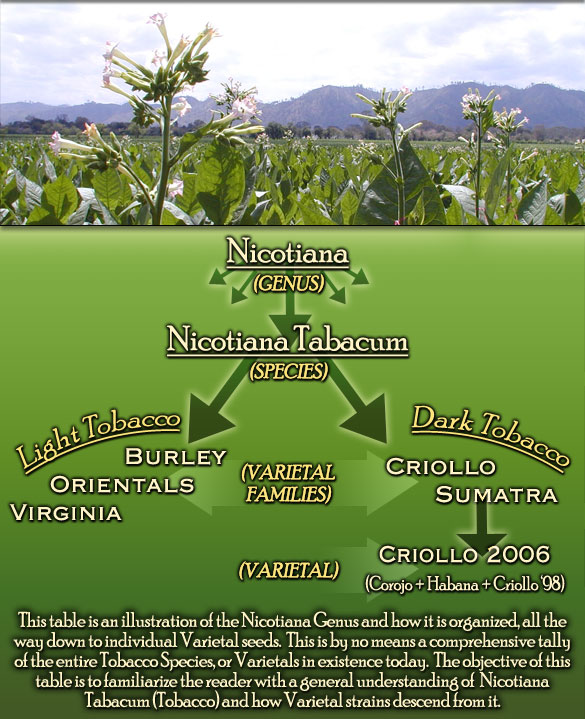I've been trying to sort the confusion of "types", "varieties", "blends", etc. in my mind. It seems tobacco terminology is played fairly fast and loose.
I can keep grape varieties fairly straight in my head as there are only a few instances of the same strain of grape having more than one name that I know of. (e.g. a riesling is a riesling no matter where it is grown) Tobacco? Not so much...
So, ignoring N. Rustica and concentrating only on N. Tabacum, I've tracked down the following list of tobacco strains:
› cv. Bottom Special
› cv. Bright Yellow
› cv. Bright Yellow 2 ,cv. BY2
› cv. Bright Yellow 4 ,BY4, cv. BY4
› cv. Burley 21
› cv. Havana
› cv. Havana 425
› cv. KY57
› cv. Michinoku
› cv. NK 326 ,cv. NK326
› cv. Petit Havana ,cv. Petite Havana
› cv. Petit Havana SR1 ,cv. Petite Havana SR1
› cv. SC58
› cv. SR1
› cv. Samsun
› cv. Samsun NN
› cv. Virginia
› cv. White Burley
› cv. Wisconsin 38 ,cv. W38
› cv. Xanthi
› cv. Xanthi NC
So now we depart the world of botany and the confusion begins.
So every "pipe" tobacco website/reference I can find claims Cavendish is really a "process" and not a "type" yet a Virginia strain can be cured and/or processed several ways but each result is referred to as a different "type" and not Virginia with a different "process"?
On top of that, if we take the Virginia strain, how does it further breakdown botanically speaking? Are red, black, lemon, orange, & orange-red actually different plants or processes or from different regions, or what?
And just for fun let's talk about Kentucky. Kentucky is, as far as I can tell, just a burley that has been specially processed. So what would happen if a Virginia was processed in the same manner?
I'm beginning to suspect that over the course of tobacco being discovered, harvested, processed, and marketed, different producers have been calling their individual products different "types" even though they were the same "type" as others but maybe they were cured for a different length of time or maybe with a different source of fuel (wood vs coal) or maybe even perhaps terrior really helped influence the final flavor?
I can keep grape varieties fairly straight in my head as there are only a few instances of the same strain of grape having more than one name that I know of. (e.g. a riesling is a riesling no matter where it is grown) Tobacco? Not so much...
So, ignoring N. Rustica and concentrating only on N. Tabacum, I've tracked down the following list of tobacco strains:
› cv. Bottom Special
› cv. Bright Yellow
› cv. Bright Yellow 2 ,cv. BY2
› cv. Bright Yellow 4 ,BY4, cv. BY4
› cv. Burley 21
› cv. Havana
› cv. Havana 425
› cv. KY57
› cv. Michinoku
› cv. NK 326 ,cv. NK326
› cv. Petit Havana ,cv. Petite Havana
› cv. Petit Havana SR1 ,cv. Petite Havana SR1
› cv. SC58
› cv. SR1
› cv. Samsun
› cv. Samsun NN
› cv. Virginia
› cv. White Burley
› cv. Wisconsin 38 ,cv. W38
› cv. Xanthi
› cv. Xanthi NC
So now we depart the world of botany and the confusion begins.
So every "pipe" tobacco website/reference I can find claims Cavendish is really a "process" and not a "type" yet a Virginia strain can be cured and/or processed several ways but each result is referred to as a different "type" and not Virginia with a different "process"?
On top of that, if we take the Virginia strain, how does it further breakdown botanically speaking? Are red, black, lemon, orange, & orange-red actually different plants or processes or from different regions, or what?
And just for fun let's talk about Kentucky. Kentucky is, as far as I can tell, just a burley that has been specially processed. So what would happen if a Virginia was processed in the same manner?
I'm beginning to suspect that over the course of tobacco being discovered, harvested, processed, and marketed, different producers have been calling their individual products different "types" even though they were the same "type" as others but maybe they were cured for a different length of time or maybe with a different source of fuel (wood vs coal) or maybe even perhaps terrior really helped influence the final flavor?







